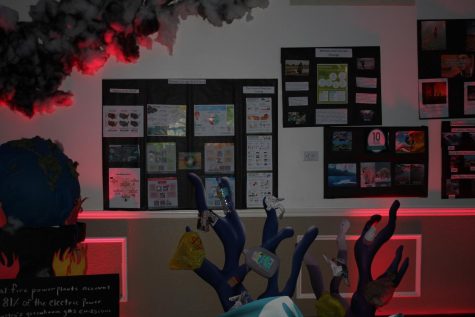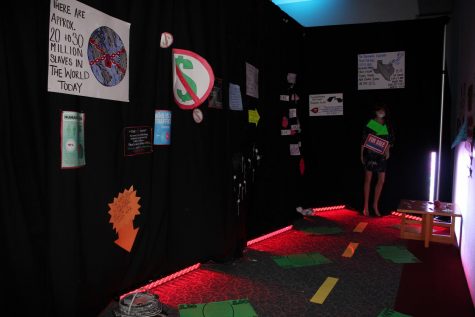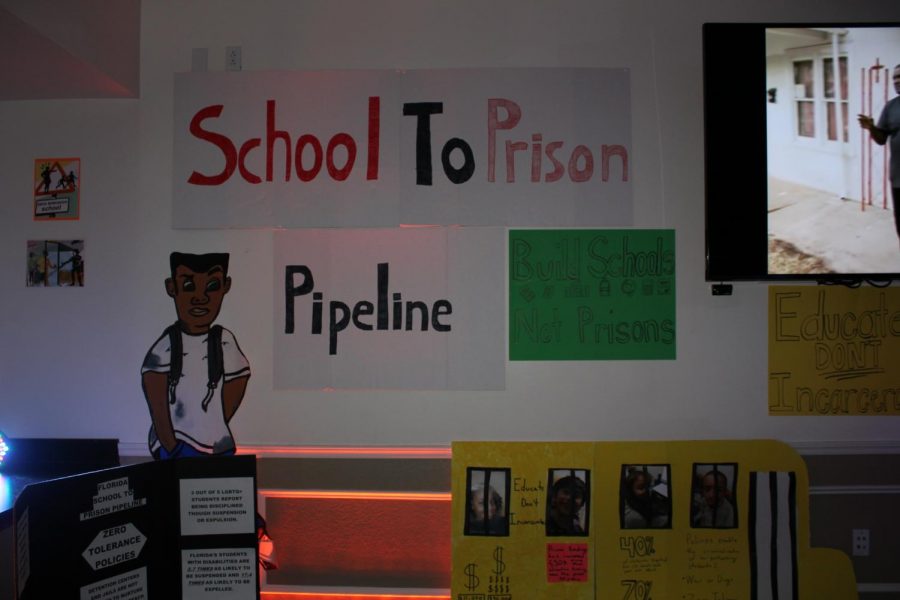FAU hosts event to inform students about oppression
The six different exhibits portrayed current issues in society, such as human trafficking and voter suppression.
The exhibits were held in a dark room, and one was on the school-to-prison pipeline, or the tendency for minorities to be incarcerated because of harsh school policies. Photo by Makayla Purvis
January 30, 2019
Last Wednesday, Thursday, and Friday, the Majestic Palm Room was home to six different exhibits meant to open students’ eyes to oppression in the world around them.
Tunnel Vision is a social justice program that demonstrates the oppression of certain groups in society — especially minorities — and it is hosted by FAU’s Center of IDEAs. Every year, different topics are selected and displayed in mini exhibits inside a large, dark room. This year’s exhibit focused on homelessness, human trafficking, voter suppression, climate change, substance abuse, and the school-to-prison pipeline.
Over 200 students attend the event every year, and the exhibits are hand-made by about 40 students, according to Assistant Vice President for Diversity and Outreach Andrea Guzman-Oliver.

“It’s an opportunity where we bring different FAU students out and expose them to different forms of oppression in society so that they get to know more about the world they live in. We hope that students will want to get involved and help break down these systems that are currently still in place,” Assistant Director for Diversity Education and Training David Bynes said.
Each exhibit was designed for students to visualize the situation. Inside of the exhibit for homelessness, for example, a camping tent with a sleeping bag and a shelter made out of cardboard boxes were widely displayed. Facts about how people who are homeless have blisters, cuts, and soles on their feet lined the walls.
Not only are the homeless faced with the challenge of keeping socks dry and clean, but nail clippers aren’t easily accessible for them to cut their toenails with, either. This can be a problem, as long toenails can cut through the socks and cause the homeless to walk around the street barefoot in weather conditions such as rain or snow, the exhibit said.
Another topic discussed was the school-to-prison pipeline, which is the tendency of minors from disadvantaged backgrounds to become incarcerated because of harsh school policies.
About 25 percent of African American students are three and a half times more likely to be suspended from school than any other race, and 50 percent of the students expelled from schools and 30 percent of the students involved in school arrests each year are African American as well, the exhibit said.
Some of these students end up expelled from school, placed in juvenile detention centers, incarcerated, or dead.
The exhibit also ventured into possible solutions like restorative justice, which is a criminal justice system that focuses on rehabilitation between the victim and the offender. Other options were to improve the student-to-staff ratio and reduce police punishment on school-related issues.
And inside the exhibit for human trafficking was a female doll with price tags attached to her and duct tape over her mouth reading “Help Me.” Human trafficking is modern-day slavery in which humans are coerced or deceived into doing free work under the threat of violence. There are approximately 20 to 30 million slaves in the world today, according to the exhibit.

About 98 percent of those victims are women, who are primarily trafficked for sex work — although 40 percent are trafficked for labor as well. The other 2 percent are men, who are typically trafficked for labor, the exhibit said.
“It seems to me that it’s kind of a human issue, that there are enough sick individuals in the world — those selling people and those buying them — that support the industry at all. The world is a broken place and things like this just make that incredibly obvious,” sophomore Alanna Barrett said while looking at the exhibit.
And those are just a few of the displays that Tunnel Vision featured.
“I think it’s really cool to learn how other people experience life that I haven’t experienced, from homelessness to even how the global climate impacted us. It’s really impactful,” Candice Davids, a student volunteer, said.
Tunnel Vision was the last event for FAU’s Social Justice week, which was held in honor of activist Martin Luther King Jr.
Makayla Purvis is a contributing writer with the University Press. For information regarding this or other stories, email [email protected].

















Joshua • Feb 5, 2019 at 12:14 pm
Yet the university still accepts thousands of dollars from either private prison companies themselves or organizations that support arbitrary detainment and unhealthy prison conditions. How can our university continue to support GEO Group when the company is a major player in the school-to-prison pipeline? How can our university continue to support GEO Group when the company underpays prisoners and produces unhealthy, abusive working conditions?
Yeah, this exhibit is great, but why not hold the university accountable for supporting these companies financially, too?